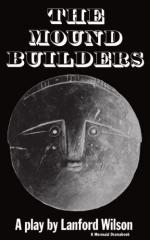The Indian guide points out these mounds to the student of history with a feeling of awe; he says he knows nothing of them; his fathers have told him that the builders of the mounds were of a different race from them—that the mounds are memorials of a vanished people—the “Ke-te-anish-i-na-be,” or “very ancient men.” The oldest Hudson’s Bay officer, and the most intelligent of the native people, born in the country, can only give some vague story of their connection with a race who perished with small-pox, but who, or whence, or of what degree of civilization they were, no clue is left.
It must be said moreover that a perusal of the works written about the mounds, especially of the very large contributions to the subject found in the Smithsonian Institution publications, leaves the mind of the reader in a state of thorough confusion and uncertainty. Indeed, the facts relating to the Mound Builders are as perplexing a problem as the purpose of the Pyramids, or the story of King Arthur.
Is it any wonder that we hover about the dark mystery, and find in our researches room for absorbing study, even though we cannot reach absolute certainty? Could you have seen the excitement which prevailed among the half-dozen settlers, I had employed in digging the mound on Rainy River, in August last, when the perfect pottery cup figured below was found, and the wild enthusiasm with which they prosecuted their further work, you would have said it requires no previous training, but simply a successful discovery or two to make any one a zealous mound explorer.
A mound described.
A mound of the kind found in our region is a very much flattened cone, or round-topped hillock of earth. It is built usually, if not invariably where the soil is soft and easily dug, and it is generally possible to trace in its neighborhood the depression whence the mound material has been taken. The mounds are as a rule found in the midst of a fertile section of country, and it is pretty certain from this that the mound builders were agriculturists, and chose their dwelling places with their occupation in view, where the mounds are found. The mounds are found accordingly on the banks of the Rainy River and Red River, and their affluents in the Northwest, in other words upon our best land stretches, but not so far as observed around the Lake of the Woods, or in barren regions. Near fishing grounds they greatly abound. What seem to have been strategic points upon the river were selected for their sites. The promontory giving a view and so commanding a considerable stretch of river, the point at the junction of two rivers, or the debouchure of a river into a lake or vice versa is a favorite spot. At the Long Sault on Rainy River there are three or four mounds grouped together along a ridge. Here some persons of strong imagination profess to see remains of an ancient fortification, but to my mind this is mere fancy. Mounds in our region vary from 6 to 50 feet in height, and from 60 to 130 feet in diameter. Some are circular at the base, others are elliptical.




